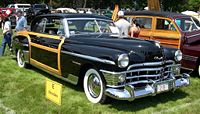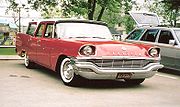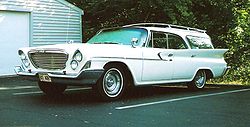.gif)
Chrysler Town and Country (pre-1990)
Encyclopedia
The Chrysler Town & Country was a station wagon
manufactured by Chrysler Corporation
and sold under its flagship brand
from 1941–1989. The model was also sold as a sedan, coupé
, and convertible
from 1947–1950 and as a convertible from 1982–1986.
Chrysler re-introduced the Town & Country nameplate as a rebadged variant
of the Dodge Caravan
minivan
in 1990 and continues to sell this incarnation of the Town & Country to the present day.
 The Town & Country was a debut of the first woodie
The Town & Country was a debut of the first woodie
wagon
with an all-steel roof; the roof used was that of the big Chrysler Imperial 8-passenger sedan and limousine, which led to a unique (and compromised) rear loading arrangement with wooden double doors that opened hutch-style beneath a fixed rear window. Production of the cars stopped during World War II
. In 1941 and 1942, less than 1,000 were manufactured.
After the war the Town & Country nameplate returned, but the station wagon body did not. Town & Country sedans, coupé
s, and convertible
s were also produced from 1946 to 1950 in much larger numbers than the prewar wagon. Production of the original, woodie Town & Country ended in 1950.
, coinciding with the debut of the company's first V8 engine (then called FireDome, but later dubbed HEMI). This wagon introduced several firsts, including roll-down rear windows for tailgate
s in 1951 and rear-facing third row seats in 1957, rear wipers in 1968, integral air deflectors in 1969 and ignition interlock to prevent children from opening the gate while the car was running in 1971.
The 1951 Town & Country wagons were offered in the Windsor
, Saratoga
and New Yorker
series. The New Yorker version disappeared for 1952, but reappeared for 1953 when the Saratoga series was dropped. The Windsor version lasted through 1960, then was moved to the new Newport
series for 1961; the New Yorker edition continued through 1965. Then in 1969, the Town & Country became a series in its own right.

 From 1960 to 1964, all Town & Country wagons were built with hardtop
From 1960 to 1964, all Town & Country wagons were built with hardtop
styling. In 1965, the Town & Country was officially placed on the Chrysler C platform
, along with such cars as the Chrysler New Yorker and Plymouth Fury
. The 1968 edition added simulated woodgrain paneling, in a way bringing it back to the tradition of the 1941–1950 Town & Country.
rear wheel drive Dodge Aspen
/Plymouth Volare wagons. The more upmarkets were considered a separate series, designated the Chrysler M platform
, which included the Chrysler LeBaron
, Dodge Diplomat
, and Plymouth Gran Fury
as well as the Town & Country. There were, however, not many substantial differences in the chassis
and powertrain
, and only Town & Country had plastic woodgrain trim on the sides.
was manufactured in 1983, which featured plastic woodgrain paneling to bring up comparisons to the original 1940s convertibles.
and Plymouth Grand Voyager
, which had both been introduced in 1984. All three vans were redesigned in 1991.
Station wagon
A station wagon is a body style variant of a sedan/saloon with its roof extended rearward over a shared passenger/cargo volume with access at the back via a third or fifth door , instead of a trunk lid...
manufactured by Chrysler Corporation
Chrysler
Chrysler Group LLC is a multinational automaker headquartered in Auburn Hills, Michigan, USA. Chrysler was first organized as the Chrysler Corporation in 1925....
and sold under its flagship brand
Chrysler (division)
Chrysler is the flagship brand of Chrysler Group LLC, named after founder Walter P. Chrysler.-Overview:The Chrysler brand was originally a premium luxury position competing with Cadillac and Lincoln, owned respectively by Chrysler Group's Detroit rivals, General Motors and Ford Motor Company...
from 1941–1989. The model was also sold as a sedan, coupé
Coupé
A coupé or coupe is a closed car body style , the precise definition of which varies from manufacturer to manufacturer, and over time...
, and convertible
Convertible
A convertible is a type of automobile in which the roof can retract and fold away having windows which wind-down inside the doors, converting it from an enclosed to an open-air vehicle...
from 1947–1950 and as a convertible from 1982–1986.
Chrysler re-introduced the Town & Country nameplate as a rebadged variant
Badge engineering
Badge engineering is an ironic term that describes the rebadging of one product as another...
of the Dodge Caravan
Dodge Caravan
The Dodge Caravan is a family minivan manufactured by Chrysler Group LLC and sold under its Dodge brand. Along with its nameplate variant, the Plymouth Voyager, the Caravan was introduced for the 1984 model year. In 1987, the Dodge Grand Caravan long-wheelbase model was introduced and sold...
minivan
Minivan
Minivan is a type of van designed for personal use. Minivans are typically either two-box or one box designs for maximum interior volume – and are taller than a sedan, hatchback, or a station wagon....
in 1990 and continues to sell this incarnation of the Town & Country to the present day.
1941–1950

Woodie
A woodie is a car body style, especially a station wagon, where the rear bodywork is constructed of wood framework with infill panels of wood or painted metal....
wagon
Station wagon
A station wagon is a body style variant of a sedan/saloon with its roof extended rearward over a shared passenger/cargo volume with access at the back via a third or fifth door , instead of a trunk lid...
with an all-steel roof; the roof used was that of the big Chrysler Imperial 8-passenger sedan and limousine, which led to a unique (and compromised) rear loading arrangement with wooden double doors that opened hutch-style beneath a fixed rear window. Production of the cars stopped during World War II
World War II
World War II, or the Second World War , was a global conflict lasting from 1939 to 1945, involving most of the world's nations—including all of the great powers—eventually forming two opposing military alliances: the Allies and the Axis...
. In 1941 and 1942, less than 1,000 were manufactured.
After the war the Town & Country nameplate returned, but the station wagon body did not. Town & Country sedans, coupé
Coupé
A coupé or coupe is a closed car body style , the precise definition of which varies from manufacturer to manufacturer, and over time...
s, and convertible
Convertible
A convertible is a type of automobile in which the roof can retract and fold away having windows which wind-down inside the doors, converting it from an enclosed to an open-air vehicle...
s were also produced from 1946 to 1950 in much larger numbers than the prewar wagon. Production of the original, woodie Town & Country ended in 1950.
1951–1959
After the woodies were discontinued, the Town & Country name was immediately transferred to a steel-bodied full-size rear wheel drive station wagonStation wagon
A station wagon is a body style variant of a sedan/saloon with its roof extended rearward over a shared passenger/cargo volume with access at the back via a third or fifth door , instead of a trunk lid...
, coinciding with the debut of the company's first V8 engine (then called FireDome, but later dubbed HEMI). This wagon introduced several firsts, including roll-down rear windows for tailgate
Tailgate
Tailgate is an American English word denoting the door or 'gate' at the back of a wagon, pickup truck, SUV or other similar type of vehicle that is hinged at the bottom and can be opened for the convenience in loading cargo into the rear of the vehicle...
s in 1951 and rear-facing third row seats in 1957, rear wipers in 1968, integral air deflectors in 1969 and ignition interlock to prevent children from opening the gate while the car was running in 1971.
The 1951 Town & Country wagons were offered in the Windsor
Chrysler Windsor
The Chrysler Windsor was a full-sized car built by the Chrysler Corporation of Highland Park, Michigan from 1939 through to the 1960s. The final Chrysler Windsor as known to Americans was produced in 1961, but continued production in Canada until 1966...
, Saratoga
Chrysler Saratoga
The Chrysler Saratoga was a full-sized automobile produced by the Chrysler Division of the Chrysler Corporation. Chrysler first used the Saratoga nameplate on its 1939 models and continued to use the name through to 1952. The name was used again by Chrysler from 1957 until 1960 when it retired the...
and New Yorker
Chrysler New Yorker
The Chrysler New Yorker was a premium automobile built by the Chrysler Corporation from 1939–1996, serving for several years as the brand's flagship model. A model named the "New York Special" first appeared in the 1930s...
series. The New Yorker version disappeared for 1952, but reappeared for 1953 when the Saratoga series was dropped. The Windsor version lasted through 1960, then was moved to the new Newport
Chrysler Newport
The Newport was a name used by the Chrysler division of the Chrysler Corporation used as both a hardtop body designation and also for its lowest priced model between 1961 and 1981...
series for 1961; the New Yorker edition continued through 1965. Then in 1969, the Town & Country became a series in its own right.

1960–1964

Hardtop
A hardtop is a term for a rigid, rather than canvas, automobile roof. It has been used in several contexts: detachable hardtops, retractable hardtop roofs, and the so-called pillarless hardtop body style....
styling. In 1965, the Town & Country was officially placed on the Chrysler C platform
Chrysler C platform
Chrysler's C platform was the basis for rear wheel drive full-size cars from 1965 to 1978. Although often misclassified, 1964 and earlier full-size Chrysler products, and 1966 and earlier Imperials are not C-bodies.Wheelbases:* 119 in...
, along with such cars as the Chrysler New Yorker and Plymouth Fury
Plymouth Fury
The Plymouth Fury is an automobile which was produced by the Plymouth division of the Chrysler Corporation from 1956 to 1978. The Fury was introduced as a premium-priced model designed to showcase the line, with the intent to draw consumers into showrooms....
. The 1968 edition added simulated woodgrain paneling, in a way bringing it back to the tradition of the 1941–1950 Town & Country.
1965–1968
1974–1977
1978–1981
Starting in 1978, and ending in 1981, the Town & Country moved to the same bodytype or shell as the compactCompact car
A compact car , or small family car , is a classification of cars which are larger than a supermini but smaller than or equal to a mid-size car...
rear wheel drive Dodge Aspen
Dodge Aspen
The Dodge Aspen, produced from 1976 to 1980, was a compact car from Chrysler Corporation's Dodge division; its Plymouth-branded counterpart was the Volaré . It was launched as a two-door coupe, a four-door sedan, and a unique-for-the-segment station wagon...
/Plymouth Volare wagons. The more upmarkets were considered a separate series, designated the Chrysler M platform
Chrysler M platform
The M-Bodies were Chrysler Corporation's successor to the F-body Aspen/Volare. The platform, almost identical to the F, was introduced in 1977 and was the basis for some mid-sized Chrysler models until its demise in 1989. The M-body was also the successor to the short-lived R-body, as the Chrysler...
, which included the Chrysler LeBaron
Chrysler LeBaron
The Chrysler LeBaron was originally a classic luxury car of 1930s manufactured by Chrysler which competed with other luxury cars of the era such as Lincoln and Packard....
, Dodge Diplomat
Dodge Diplomat
The Dodge Diplomat is an American mid-size car made from 1977 to 1989. It is substantially identical to the Chrysler- and Plymouth-branded versions of Chrysler's M-body cars, including the Chrysler LeBaron and New Yorker Fifth Avenue and the Plymouth Gran Fury in the U.S. market and the Plymouth...
, and Plymouth Gran Fury
Plymouth Gran Fury
The Plymouth Gran Fury is an automobile manufactured by the Chrysler Corporation to signify Plymouth's largest full-size automobile from 1975 to 1977. The nameplate would be used on successive downsizings, first in 1980, and again in 1982, through what would originally have been intermediate and...
as well as the Town & Country. There were, however, not many substantial differences in the chassis
Chassis
A chassis consists of an internal framework that supports a man-made object. It is analogous to an animal's skeleton. An example of a chassis is the underpart of a motor vehicle, consisting of the frame with the wheels and machinery.- Vehicles :In the case of vehicles, the term chassis means the...
and powertrain
Powertrain
In a motor vehicle, the term powertrain or powerplant refers to the group of components that generate power and deliver it to the road surface, water, or air. This includes the engine, transmission, drive shafts, differentials, and the final drive...
, and only Town & Country had plastic woodgrain trim on the sides.
1982–1989
From 1982 to 1989, the Town & Country name was used on a station wagon version of the K-based, front wheel drive LeBaron, featuring plastic woodgrain exterior trim. A special Town & Country convertibleConvertible
A convertible is a type of automobile in which the roof can retract and fold away having windows which wind-down inside the doors, converting it from an enclosed to an open-air vehicle...
was manufactured in 1983, which featured plastic woodgrain paneling to bring up comparisons to the original 1940s convertibles.
1990–present
In 1990 the Town & Country name was applied to a the new Chrysler branded luxury minivan, based on the Dodge Grand CaravanDodge Caravan
The Dodge Caravan is a family minivan manufactured by Chrysler Group LLC and sold under its Dodge brand. Along with its nameplate variant, the Plymouth Voyager, the Caravan was introduced for the 1984 model year. In 1987, the Dodge Grand Caravan long-wheelbase model was introduced and sold...
and Plymouth Grand Voyager
Plymouth Voyager
In 1984, the Voyager name was applied to Plymouth's variant of Chrysler's all new minivan. This Voyager used the Chrysler S platform, which was derived from the K-platform . In addition to using a derived platform, the Voyager shared many components with the K-cars, most notably the interior...
, which had both been introduced in 1984. All three vans were redesigned in 1991.

